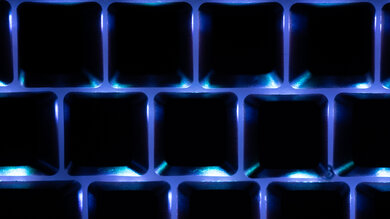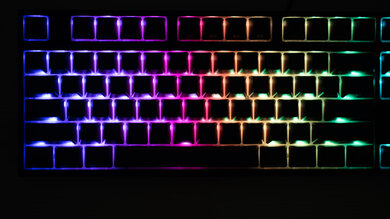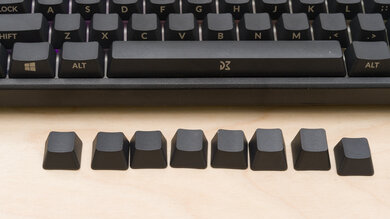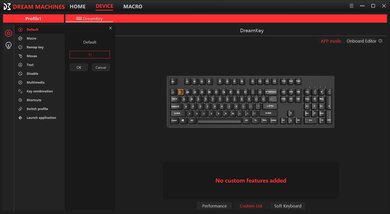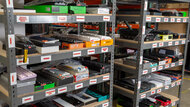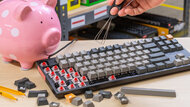The Dream Machines DreamKey is a wired-only, mechanical gaming keyboard available in full and TKL-size options. It's the first keyboard from Polish manufacturer Dream Machines, and it feels very well-built with an aluminum chassis and PBT keycaps that have the key legends printed on the front side of the keycap rather than on top. We tested the full-size variant with tactile Kailh Box Brown switches, which feel light to type on and offer good tactile feedback, but you can also get the keyboard with clicky Kailh Box White or linear Kailh Box Red switches. Unfortunately, while the latency is okay, it's still higher than most other dedicated gaming options. Also, it doesn't include a wrist rest, which would greatly improve the ergonomics.
Our Verdict
The Dream Machines DreamKey is a superb keyboard for gaming. It feels very well-built and has excellent RGB backlighting, fully customizable using the companion software. All its keys are macro-programmable, and the Kailh Box Brown switches on our unit provided great tactile feedback. You can also get this board with linear Kailh Box Red switches or clicky Kailh Box White switches if you prefer. Unfortunately, its ergonomics are only okay as it lacks a wrist rest. Also, its click latency is adequate, but it's still higher than other gaming options.
-
Feels very well-built.
-
Full RGB backlighting with individually lit keys.
-
All keys are macro-programmable.
-
No wrist rest included.
The Dream Machines DreamKey is a wired-only keyboard, so it's not suitable for use with a tablet or mobile device.
The Dream Machines DreamKey is a good keyboard for office use. The Kailh Box Brown switches feel good to type on and provide nice tactile feedback when you press the key. They're also very quiet and unlikely to disturb others around you. It feels very well-built, and it's fully compatible with Windows, but the software and some of the default button settings don't work with macOS. Also, its ergonomics are only okay, as it doesn't include a wrist rest, which would greatly improve the comfort during long periods of use.
-
Feels very well-built.
-
Full RGB backlighting with individually lit keys.
-
All keys are macro-programmable.
-
Excellent typing quality.
-
No wrist rest included.
-
No software available for macOS.
The Dream Machines DreamKey is a very good keyboard for programming. All of its keys are macro-programmable, and it feels well-built. Its backlighting is excellent; however, the key legends aren't translucent, so the light doesn't shine through. While it's fully compatible with Windows, it lacks software for macOS or Linux systems. While it does feel comfortable to type on, it lacks a wrist rest, meaning it may get uncomfortable during long working sessions.
-
Feels very well-built.
-
Full RGB backlighting with individually lit keys.
-
No wrist rest included.
-
No software available for macOS.
The Dream Machines DreamKey is a poor keyboard to use with a home entertainment system, but it wasn't designed for this use anyway. It doesn't connect wirelessly, so you'll have to plug it in directly to a computer to use, and it lacks a trackpad, so you'll have to use a separate mouse anyway. However, its RGB backlighting is bright to help you see the keys in the dark, but it doesn't shine through to illuminate the key legends.
-
Feels very well-built.
-
Full RGB backlighting with individually lit keys.
-
No wrist rest included.
-
Wired-only connection.
-
No trackpad/track ball for on-screen navigation.
- 9.0 Gaming
- 2.8 Mobile/Tablet
- 7.6 Office
- 7.8 Programming
- 3.4 Entertainment / HTPC
Changelog
- Updated Jan 28, 2022: Review published.
- Updated Jan 24, 2022: Early access published.
- Updated Jan 13, 2022: Our testers have started testing this product.
- Updated Jan 10, 2022: The product has arrived in our lab, and our testers will start evaluating it soon.
- Updated Dec 25, 2021: We've purchased the product and are waiting for it to arrive in our lab.
Check Price
Differences Between Sizes And Variants
The Dream Machines DreamKey comes in your choice of clicky Kailh Box White, linear Kailh Box Red, or tactile Kailh Box Brown switches. It also comes in a TenKeyLess variant. We tested the full-size keyboard with tactile Kailh Box Brown switches. You can see the label of our unit here.
Compared To Other Keyboards
The Dream Machines DreamKey is a mechanical gaming keyboard available in full and TKL-size options. While its latency is okay, it's not as low as other gaming options, so it's not well-suited for fast-paced or competitive games. A unique feature of this keyboard is that the key legends are printed on the front side of the keycap rather than on top; however, this aesthetic quality doesn't impact the typing experience. Unfortunately, it doesn't include a wrist rest, which would greatly improve the ergonomics as it's a bit high-profile.
For more options, check out our recommendations for the best mechanical keyboards, the best RGB keyboards, and the best gaming keyboards under $100.
The Apple Magic Keyboard 2017 and the Dream Machine DreamKey are two very different keyboards designed for different uses. The Apple is a low-profile TKL board designed for office use with Apple-made products. It connects wirelessly with Bluetooth only, and it has white-only backlighting. The DreamKey is a full-size mechanical gaming keyboard that has macro-programmable keys, RGB backlighting, and it's wired-only.
The Dierya x KEMOVE DK61 Pro and the Dream Machines DreamKey are mechanical gaming keyboards. The Dierya is a 60% compact size wireless model that connects with up to three devices using a Bluetooth connection. Also, when used in a wired mode with its charging cable, it has better latency than the Dream Machines. On the other hand, the Dream Machines is a full-sized board that you can only use with a wired connection.
The Drop CTRL and the Dream Machines DreamKey are mechanical gaming keyboards with different features. The Drop is a TenKeyLess size, and it has a better build quality and better latency. Also, it has a USB passthrough feature. On the other hand, the Dream Machines is a full-size board with incline settings for better ergonomics. The Dream Machines also has a Windows key lock feature, and it has companion software to customize the keyboard.
The Drop ALT and the Dream Machines DreamKey are mechanical gaming keyboards, but they have different features. The Drop is a 65% size compact board that has a better build quality, more incline settings for better ergonomics, and significantly better latency. It also has a USB passthrough feature. The Dream Machines has companion software to customize the board, and every key is macro-programmable. Also, it has a Windows key lock feature, which the Drop lacks.
The Razer Huntsman and the Dream Machines DreamKey are mechanical gaming keyboards that use a wired-only connection. However, the Razer performs better overall. It has a shorter pre-travel distance than the Kailh Box Brown switches we tested on the Dream Machines, and it has significantly better latency and much better color mixing. Also, the Razer Synapse 3 software is much more intuitive and easy to use. On the other hand, the Dream Machines has a better build quality and has PBT keycaps for a less slippery feel, and its cable is detachable. It's also available in three different switch types, while the Razer only comes with one possible switch type.
Test Results
The Dream Machines DreamKey feels very well-built. Its aluminum and hard plastic body has very little flex and feels very solid. The keycaps are made of PBT with the legends printed using dye sublimation. Interestingly, the legends are on the sides of the keys rather than on the top, giving it a unique aesthetic that might take some getting used to at first. There are four rubber pads on the bottom, which do a good job of keeping the board in place, and the inclined feet feel sturdy and are covered in soft-touch plastic. Unfortunately, the keys wobble a little, but it's not enough to impact usage. Also, there's a metal plate on the top right side that should be glued down; however, it unsticks easily, which doesn't affect normal use, but it could be a nuisance if you tend to bring your keyboard around.
The Dream Machines DreamKey has okay ergonomics. It has one incline setting, but it's a little on the thicker side. Unfortunately, it doesn't include a wrist rest, which would improve the overall ergonomics of the board.
The Dream Machines DreamKey has excellent RGB backlighting. Each of its keys is individually backlight, and you can customize the colors and effects using the companion software. Unfortunately, its color mixing is poor, and the lighting has a very purple/blue hue. Also, since the key legends aren't translucent, the light doesn't shine through them, meaning they may be difficult to see in the dark.
Dream Machines advertises a braided cable; however, we received a standard rubber USB-C cable with our unit, which is a bit stiff and retains kinks from its packaging.
All of the keys are macro-programmable, except for the function key. You can enable a Windows key lock feature by pressing the Fn key and the Windows key simultaneously. While there aren't dedicated media keys, you can assign them to hotkeys in the software. Also, this keyboard comes with a full anti-ghosting feature.
Our Dream Machines DreamKey came with tactile Kailh Box Brown switches. They feel light to type on and slight tactile bump to overcome during actuation. It's also available with clicky Kailh Box White switches or linear Kailh Box Red switches if you'd prefer something that feels snappier.
The typing experience on the Dream Machines DreamKey feels great. Our unit has the Kailh Box Brown switches, which provide good tactile feedback. The keys feel well-spaced, and the PBT keycaps have a good texture that feels nice to type on. Though there's a slight wobble in the keys, it isn't noticeable during typing. Overall, the board is comfortable to type on, but it would benefit from a wrist rest to help keep the wrist comfortable. The DreamKey is also available with linear Kailh Box Red switches or with clicky Kailh Box White if you'd prefer a different feel.
The Kailh Box Brown switches on our Dream Machines DreamKey are quiet to use. However, the noise levels will be louder with the clicky switches.
The click latency on the Dream Machines DreamKey is okay, but it's likely too high for fast-paced or competitive games. However, it should feel more than responsive enough for casual gaming and daily tasks.
The Dream Machines DreamKey uses software that goes by the same name. You can use the software to customize the RGB backlighting or assign hotkeys or macros. You can also set a "layer" of hotkey assignments that only work while pressing an assigned "function" key. While the software looks very basic, it can be difficult to use, especially when programming layers, macros, or saving profiles to the onboard memory. To save settings to the onboard memory, you'll have to do that in a tab called "Onboard Editor" and re-apply all settings in that tab, even if you have hotkeys and macros already assigned.
All the default key bindings on the Dream Machines DreamKey work on Windows, and only the Pause/Scroll Lock buttons don't work on macOS. Unfortunately, since the companion software is only available for Windows, you can't adjust the board while using it with other operating systems.
Comments
Dream Machines DreamKey: Main Discussion
Let us know why you want us to review the product here, or encourage others to vote for this product.






